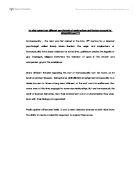Command and Control - Assignment 1
Police Constable
Police Sergeant
Inspector
Chief Inspector
Below is the rank structure for the UK police force, starting from constable al the way up to chief constable.
Superintendent
Chief Superintendent
Assistant Chief Constable
Deputy Chief Constable
Chief Constable
Police constable - These are the most common police officers you will see, they patrol the streets and are called out to deal with any problems.
Police Sergeant - Sergeants are in control of the constables and will send them out to do different things in different areas, they are in charge of about 6 constables.
Inspector - Inspectors are in charge of the custody sergeants, which are involved with registering the cells and dealing with court cases. They are also in charge of a uniformed team which would consist of 6 constables and 1 sergeant.
Chief Inspector - Chiefs inspectors are in charge of all the operations that they would undertake, like a drugs raid for example.
Superintendent - Superintendents would be the police that attend all the meeting with councillors and discuss several policies. They tend to work behind the scenes and are not involved with all the arrests etc.
Police Constable
Police Sergeant
Inspector
Chief Inspector
Below is the rank structure for the UK police force, starting from constable al the way up to chief constable.
Superintendent
Chief Superintendent
Assistant Chief Constable
Deputy Chief Constable
Chief Constable
Police constable - These are the most common police officers you will see, they patrol the streets and are called out to deal with any problems.
Police Sergeant - Sergeants are in control of the constables and will send them out to do different things in different areas, they are in charge of about 6 constables.
Inspector - Inspectors are in charge of the custody sergeants, which are involved with registering the cells and dealing with court cases. They are also in charge of a uniformed team which would consist of 6 constables and 1 sergeant.
Chief Inspector - Chiefs inspectors are in charge of all the operations that they would undertake, like a drugs raid for example.
Superintendent - Superintendents would be the police that attend all the meeting with councillors and discuss several policies. They tend to work behind the scenes and are not involved with all the arrests etc.







